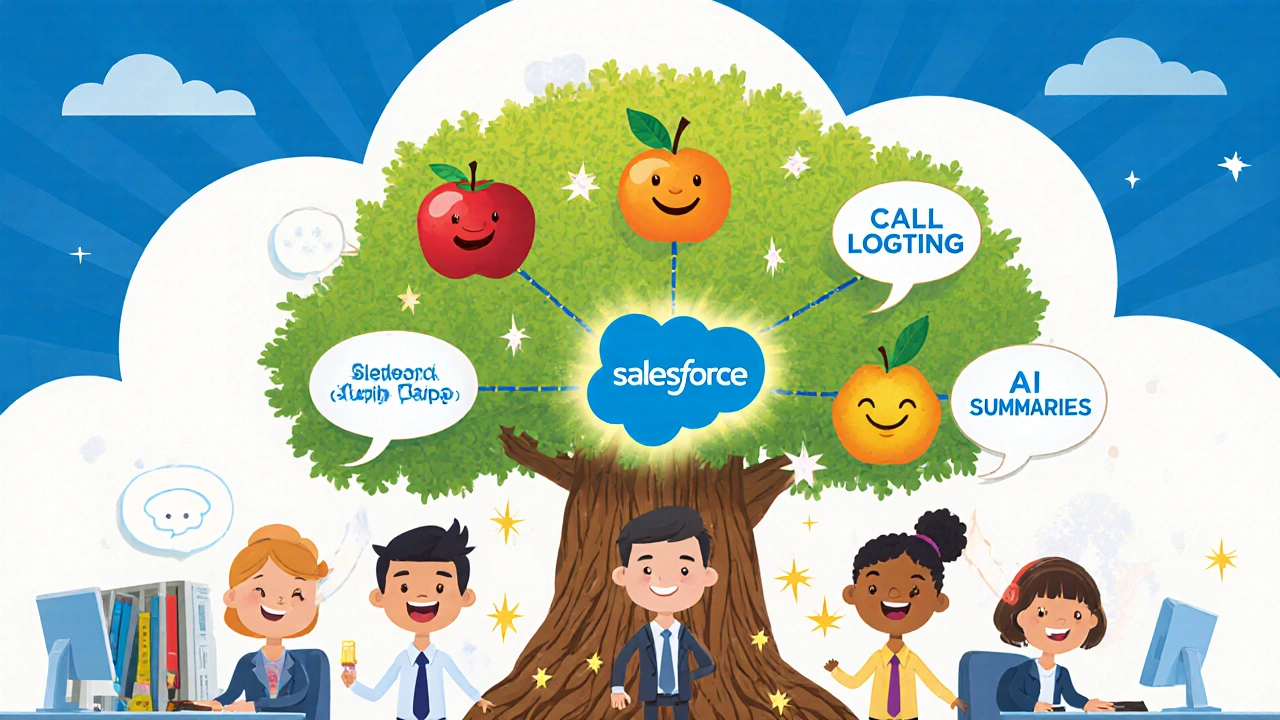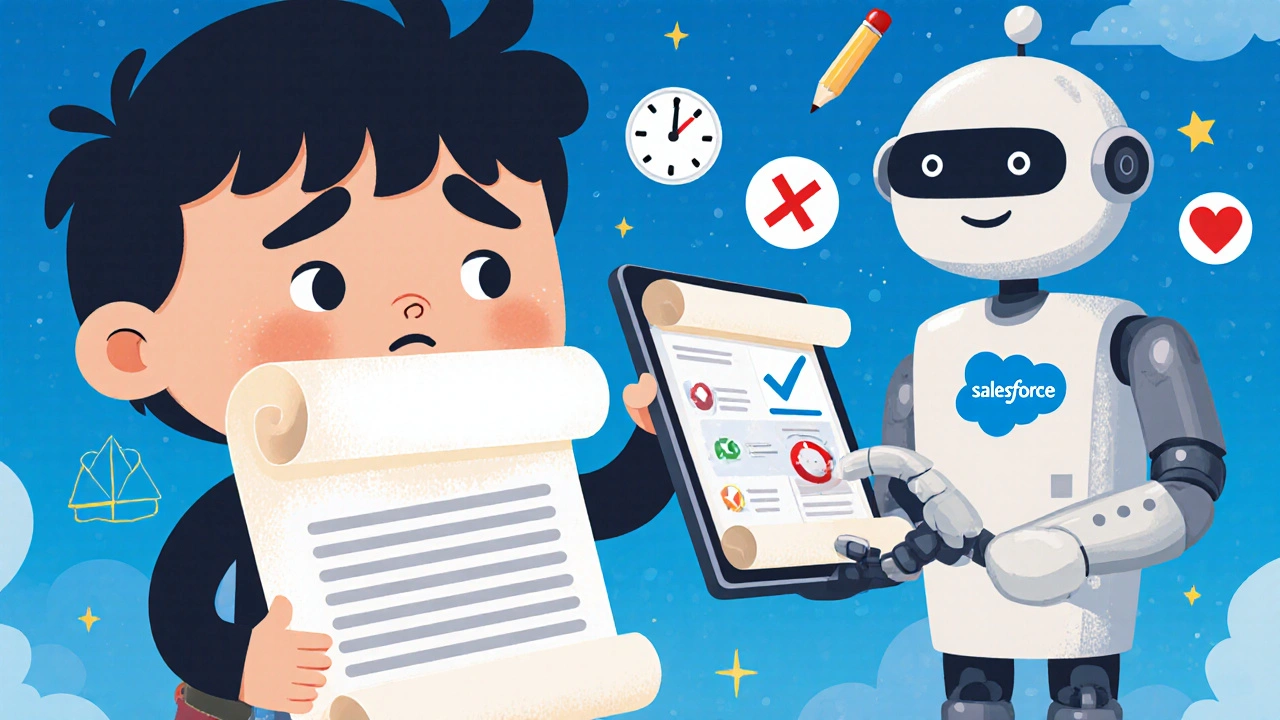Imagine you’re on a call with a customer. Their name, past purchases, open support tickets, and even their last email pop up on your screen before you even say hello. No typing. No switching tabs. No guessing. That’s what VoIP and Salesforce integration does - and it’s not science fiction. It’s a reality for thousands of sales and support teams right now.
If you’re still manually logging calls, searching for customer records, or juggling between your phone and CRM, you’re wasting hours every week. Studies show teams using integrated VoIP and Salesforce systems reduce call logging errors by up to 35% and boost agent productivity by 25-30%. But setting it up right? That’s where most teams get stuck.
What Exactly Is VoIP and Salesforce Integration?
VoIP (Voice over Internet Protocol) lets you make calls over the internet instead of traditional phone lines. Salesforce is your CRM - the system that holds every customer interaction, deal, and note. Integration means they talk to each other in real time.
When a customer calls, Salesforce automatically pulls up their profile. You can click to dial from within Salesforce. After the call ends, details like duration, notes, and even call recordings sync back automatically. No more scribbling on sticky notes or forgetting to log calls.
This isn’t just about convenience. It’s about accuracy. A 2024 Girikon study found that 65% of customers expect instant support. If your team can’t pull up their history fast, you’re losing trust before the first sentence is spoken.
The backbone of this integration is Salesforce’s Open CTI (Computer Telephony Integration) framework. It’s a set of JavaScript APIs that let your phone system talk to Salesforce without plugins or browser extensions. It works in Lightning Experience - the modern Salesforce interface - and requires API version 52.0 or higher.
How It Works: The Core Features
Here’s what you actually get when VoIP and Salesforce are connected:
- Screen pops: As soon as a call comes in, the customer’s record appears on your screen. This happens in under 2.5 seconds in well-configured systems.
- Click-to-dial: Instead of dialing manually, just click a phone number in Salesforce. The call goes out through your VoIP system.
- Automatic call logging: Call time, date, outcome, and even your voice notes get saved directly to the contact or account record.
- Call recording: Record calls for training, compliance, or quality control - with consent built into the process.
- Call transfer and hold: Transfer calls between agents or put them on hold without leaving Salesforce.
Service Cloud Voice, Salesforce’s native telephony solution launched in 2020, takes this further. It’s built on Amazon Connect and adds AI features like real-time sentiment analysis, call summarization, and agent assist prompts. These tools can cut after-call work by 35%, according to Salesforce’s own developer guide.
Choosing Your Integration Approach
You’ve got four main paths to choose from. Each has trade-offs in cost, complexity, and features.
1. Third-Party AppExchange Apps (Most Popular)
These are pre-built integrations from VoIP providers like Vonage, Five9, RingCentral, and Aircall. They’re listed on Salesforce AppExchange and rated by users.
Pros:
- Plug-and-play setup for supported systems
- Full feature sets: screen pops, call logging, analytics
- 24/7 vendor support
Cons:
- $50-$150 per user/month
- Some require developer help for advanced tweaks
Top picks in 2024:
- Vonage Contact Center: 4.6/5 rating, strong for enterprise teams
- Five9: 4.5/5, best for high-volume call centers
- Aircall: 4.4/5, great for startups and small teams
2. Salesforce Native Lightning Dialer
This is Salesforce’s own dialer, built into Service Cloud. It’s simple and fully native.
Pros:
- No third-party software needed
- Seamless with Salesforce updates
- $50/user/month plus $0.015 per outbound minute
Cons:
- Only works with Salesforce’s telephony infrastructure
- Limited customization
- Inbound calls cost $0.025/minute
Best for teams already using Salesforce as their primary phone system.
3. Service Cloud Voice (Enterprise-Only)
This is the most powerful - and most expensive - option. Requires Service Cloud Enterprise license ($150/user/month) plus Amazon Connect costs.
Pros:
- AI-powered call summaries and sentiment analysis
- Real-time agent coaching
- Deep integration with Amazon Connect
Cons:
- Implementation costs: $15,000-$50,000 for mid-sized companies
- Requires specific data models to work right
- Overkill for small teams
Gartner analyst Mark Smith warns: “Salesforce telephony solutions often carry hidden costs in required add-ons that can increase total cost of ownership by 40-60%.”
4. Browser Extensions (Budget Option)
Tools like Click to Call CTI for CRM from Thirdlane cost under $10/user/month.
Pros:
- Very cheap
- Easy to install
Cons:
- Only does click-to-dial
- No screen pops
- No call logging
- Not reliable for teams over 10 people
Use this only if you’re testing the waters or have zero budget.

Step-by-Step Setup Guide
Here’s how to actually get it working - no fluff, just the steps.
- Check your Salesforce edition: You need Enterprise Edition or higher. Service Cloud Voice requires Service Cloud licenses.
- Install the telephony app: Go to AppExchange, search for your VoIP provider (e.g., Vonage, Five9), and install the package. Admin permissions required.
- Configure Call Centers: In Setup, search for “Call Centers.” Click “New.” Give it a name like “Sales Team VoIP.”
- Upload the Call Center Definition File: Your VoIP provider gives you an XML file. Upload it here. This file tells Salesforce how to connect - adapter URLs, phone number formats, screen pop rules. Get this wrong, and 42% of integrations fail.
- Authenticate: Enter your VoIP provider’s credentials (API key, username, password). Test the connection.
- Assign users: Go to the Call Center record, click “Manage Users,” and add the agents who need access.
- Customize screen pops: In the Call Center Definition File, set which fields trigger the pop - phone number, email, account ID. Make sure your number formats match (e.g., +44 20 1234 5678 vs. 02012345678).
- Test with a pilot group: Start with 3-5 users. Use Salesforce’s CTI Health Check tool to verify everything works.
For non-supported providers, manual setup can take 20-40 hours. For supported ones (like Amazon Connect or Five9), it’s usually 2-4 hours.
Common Pitfalls and How to Fix Them
Even with good instructions, things go wrong. Here’s what breaks most often:
- Phone number format mismatch: Your CRM has +44 20 1234 5678. The caller dials 02012345678. Salesforce doesn’t match them. Fix: Use Flow or Apex triggers to standardize numbers before lookup.
- Incorrect contact lookup order: You want the account record to pop up, but it’s pulling up a contact instead. Fix: In the Call Center Definition File, change the lookup order to Account > Contact > Lead.
- Permission errors: Users can’t see the softphone. Fix: Assign them the “Call Center Administrator” profile or custom permission set.
- CORS or SSL errors: Browser blocks the connection. Fix: Add your VoIP provider’s domain to Salesforce’s CSP Trusted Sites in Setup.
- Screen pop delays: Takes longer than 3 seconds. Fix: Reduce the number of fields loaded on pop. Use lazy loading or reduce related records pulled.
One user on Salesforce Stack Exchange solved 75% of missed connections by writing a custom Apex trigger that matched phone numbers to account records - even if the number was stored differently.
What You Need to Know Before You Start
Before you invest time or money, ask yourself:
- Do you have Salesforce Admins on your team? You’ll need them.
- Are your phone numbers consistent across your CRM? If not, clean them first.
- Are you ready for ongoing maintenance? Integrations break when Salesforce updates or your VoIP provider changes their API.
- Do you need call recording? If yes, make sure you’re compliant with GDPR (EU) and FCC (US) rules - customers must consent.
Companies with 500+ employees are 3.2x more likely to use managed solutions. SMBs often stick with basic click-to-dial. Know your scale.

Real-World Results
Here’s what teams see after a successful integration:
- 40% faster call handling (based on Girikon benchmarks)
- 30% reduction in after-call work thanks to auto-logging
- 20% increase in conversion rates - reps can personalize faster
- 15% fewer customer complaints about “I already told you that”
One UK-based SaaS company cut their average call handle time from 8.2 minutes to 5.7 minutes after switching to Five9 + Salesforce. Their CSAT score jumped from 78% to 91% in six months.
What’s Next? AI and the Future
Salesforce’s Spring ’25 update will add native WhatsApp integration and better CTI health monitoring. By 2026, Forrester predicts 80% of new integrations will include AI call summaries that auto-write follow-up tasks.
WebRTC adoption is growing - 35% of new VoIP systems now use it for browser-based calling. That means even more seamless integration without needing a desktop app.
But security is a growing concern. Salesforce’s 2024 Trust Report shows 12% of security incidents involved compromised telephony integrations. Always use MFA, monitor login activity, and restrict API access.
Final Thoughts
Voice is still the most trusted channel for customer service. But if your phone and CRM aren’t talking, you’re working harder than you need to. The right integration turns your phone into a smart sales tool - not just a ringing box.
Start small. Test with a pilot group. Fix the basics: number formats, permissions, screen pops. Then scale. You don’t need Service Cloud Voice on day one. But you do need to stop typing phone numbers by hand.
Can I integrate VoIP with Salesforce without paying for a third-party app?
Yes, but with limits. Salesforce’s native Lightning Dialer works without third-party apps and costs $50 per user/month plus per-minute charges. It supports click-to-dial and call logging, but lacks advanced features like screen pops or AI tools. For basic needs, it’s enough. For teams that rely on customer context during calls, a third-party app is worth the investment.
What’s the difference between Open CTI and Service Cloud Voice?
Open CTI is the framework that lets any VoIP provider connect to Salesforce. It’s the plumbing. Service Cloud Voice is a complete telephony system built by Salesforce on Amazon Connect. It includes Open CTI but adds AI features like real-time sentiment analysis, call summarization, and agent coaching. Think of Open CTI as the connection, and Service Cloud Voice as the full phone system with smart features.
Why won’t my screen pop show the right customer record?
Most often, it’s because the phone number format doesn’t match. If your CRM stores numbers as +44 20 1234 5678 but the caller dials 02012345678, Salesforce won’t match them. Fix it by standardizing numbers using Flow or Apex triggers. Also check your Call Center Definition File - the lookup order might be set to Contact instead of Account. Change it to Account > Contact > Lead.
Do I need a developer to set this up?
Not always. If you’re using a top-rated AppExchange app like Vonage or Five9, their setup guides are clear and often work with just admin access. But if you’re using a lesser-known provider, need custom screen pop rules, or have complex phone number formats, you’ll likely need someone with Salesforce Admin skills and basic JavaScript knowledge. For Service Cloud Voice, Salesforce recommends a certified admin plus a developer for advanced configurations.
Is VoIP and Salesforce integration worth the cost?
If your team spends more than 10 minutes per day logging calls or searching for customer info, yes. One company found they saved 22 hours per week across 12 agents - that’s over 1,100 hours a year. That’s the equivalent of hiring another full-time rep. Even at $100/user/month, the ROI is clear. The real cost isn’t the software - it’s the lost time, errors, and unhappy customers from not having it.
What happens if my VoIP provider changes their API?
Your integration might break. That’s why it’s critical to choose providers with strong Salesforce partnerships - like Vonage, Five9, or RingCentral. They monitor Salesforce updates and notify you before changes hit. Avoid small providers with poor documentation. If your system stops working after a Salesforce update, check the provider’s status page or contact support immediately. Always test updates in a sandbox first.
